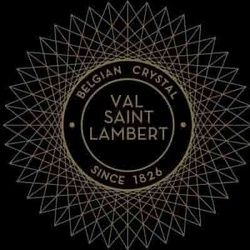
Val Saint Lambert - бельгийский производитель хрустальной посуды, основанный в 1826 году и Располагается в Серене . Он имеет королевский ордер короля Альберта II .
Предыстория - стекольный завод Вонече.
В 1795 году во время войны Первой коалиции, которая привела к падению Голландской республики , Франция аннексировала то, что тогда называлось Южными Нидерландами, теперь известными как Бельгия . В период наполеоновских войн в 1802 году Наполеон Бонапарт попросил французского промышленника Анри Д'Артига покинуть известного французского производителя хрусталя Сен-Луи для покупки ветхого стекольного завода в Вонече . Как и Сен-Луи, Вонеч производил свинцовый хрустальстекло, и в течение десяти лет стал крупнейшим производителем кристаллов во французской империи. Двумя ключевыми работниками на заводе были химик Франсуа Кемлин и инженер Огюст Лельевр. В 1815 году после поражения Наполеона в битве при Ватерлоо южные Нидерланды были объединены в новое Соединенное Королевство Нидерландов . В результате недавно введенных импортных пошлин фабрика Vonêche сразу потеряла большую часть своего французского рынка. В 1816 году D'Artigues договорился с французским королем Людовиком XVIII о покупке стекольного завода Verrerie de St Anne в городе Баккара и переименовал его в Verrerie de Vonêche à Baccarat - название, которое он сохранил до 1843 года. Бельгийская революция1830 года означало, что стекольный завод Vonêche также потерял большую часть своего рынка в Южной Голландии и поэтому вскоре был закрыт.
История.
В 1825 году Кемлин и Лельевр приобрели участок бывшего аббатства Валь-Сен-Ламбер в Серайнге около Льежа на реке Мёз . Там они основали новый стекольный завод (до сих пор действующий, первоначально ориентированный на тяжелые свинцовые кристаллы), в котором первоначально работали некоторые из ключевых работников бывшего стекольного завода Вонеч. [1]Первоначально два основателя построили для себя два дома и заблокировали жилье для бывших рабочих Vonêche. Подобно таким же высокорелигиозным работодателям, эта политика полного развития образа жизни в конечном итоге привела к тому, что компания построила на этом участке более 200 домов для работников, которые стали деревней самообслуживания, в которой также были универсальный магазин, школа и почтовое отделение; местная римско-католическая церковь также была расширена для размещения дополнительных верующих.
Благодаря качеству своих конструкций и производственного процесса, компания разработала известный бренд и расширилась. Помимо родной территории Бельгии и Нидерландов , крупнейшим экспортным рынком была тогдашняя царская Россия . В 1876 году компания открыла дистрибьюторскую базу в Нью-Йорке , а в 1889 году генеральный директор компании посетил магазин и посетил местные заводы-конкуренты Восточного побережья. В результате по возвращении в Бельгию генеральный директор отметил в своем отчете тогдашнее превосходное качество американского стекла и мастерство его хрустальных фрез, на которые компания отреагировала, разработав собственные «яркие» диапазоны и высочайшее качество резки. [2]Получившийся «яркий период» расширил репутацию компании и рынок, особенно в Северной Америке, и, следовательно, сегодня он хорошо известен и собран там для своих произведений в стиле модерн и ар-деко . В 1894 году на всемирной выставке в Антверпене компания изготовила вазу высотой более 2 метров, состоящую из 82 деталей весом 200 килограммов, которая до сих пор не повреждена и выставлена в музее Курция в Льеже. По мере того, как компания становилась более успешной - в период с 1900 по 1914 год на ней работало более 5000 рабочих, которые производили по 120 000 штук стекла в день, - компания заключила контракт с другими заводами. позднее либо покупая их, либо открывая новые заводы, в том числе: Джемепп (с 1883 по 1952 год); два возле Намюра (1879–1935); и Jambes (1880–1931, производство масляных стеклянных ламп).
Компания прекратила производство во время Первой мировой войны , а после войны после русской революции рынок в России полностью рухнул, что привело к финансовым трудностям и сокращению. Экспорт в Северную Америку спас компанию, но он снова столкнулся с трудностями после краха этого рынка после краха Уолл-стрит в 1929 году . Таким образом, компания закрыла фабрики Jambes и два завода в Намюре и была стабильной ко времени Второй мировой войны , во время которой, как и большая часть Бельгии, завод подвергся бомбардировке как нацистскими люфтваффе, так и союзными военно-воздушными силами RAF и USAAF., Первоначально производство возобновилось на фабрике в Джемеппе, которая была менее повреждена бомбами, до тех пор, пока производственные линии не могли быть восстановлены в Сераинге, что привело к закрытию фабрики в Джемеппе в 1950-х годах. В то время как многие здания в Серайнге были восстановлены, значительная часть территории оставалась такой же, какой была после Второй мировой войны, до начала 2000-х годов, когда эти заброшенные здания 19-го века были очищены, чтобы создать современный стальной каркасный завод, центр для посетителей и небольшой заводской цех. которые существуют сегодня вместе с оригинальными отреставрированными фабричными офисами 19-го века.
Благодаря опыту уникальных мастеров и привлечению международных художников хрустальный завод Val Saint Lambert в настоящее время известен своей продукцией в более чем сорока странах, в США, Саудовской Аравии, Испании и Японии. Поставщик Королевских домов, производитель уникальных предметов престижа и ценных трофеев (спортивные и другие кубки и награды), Val Saint Lambert, знаменит своими великолепными изделиями из хрусталя «двухцветного гранения». Val Saint Lambert также предлагает коллекции редких изделий, соединяющих в себе благородные металлы, такие как бронза, серебро и золото.







